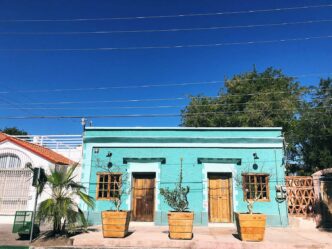The big “G” word has been trending nationally since the beginning of July. Following the protests on July 4th in Mexico City, Mayor Clara Brugada unveiled a 14-point plan aimed at combating gentrification and ensuring the right to housing for all residents. Gentrification might seem like a hot new topic, but it has been at the forefront of residents’ minds, especially in more touristic areas around Mexico for years, like at Quintana Roo state.
Here in La Paz, gentrification has been slowly creeping in. In Los Cabos, it began with the boom of timeshare companies paying huge rents for commercial spaces in downtown Cabo San Lucas and amplified exponentially during the pandemic in residential areas.
This influx, combined with tourism and short-term rentals, has demonstrably led to a rapid escalation in housing prices, a boom in the real estate market, and a severe strain on public infrastructure, contributing to the displacement of local families.
Following this national trend, news outlets across La Paz have been highlighting the various issues residents deal with as a consequence of gentrification. In an interview with the news channel Meganoticias on July 16, La Paz resident and political analyst Adriana Borges expressed her concerns: “The issues of water, collapsed drainage in many parts of the city, and the electrical energy problems we’ve experienced, with blackouts during the summer, are simply due to insufficient resources to meet demand.” The issue affects everyone.
The term gentrification itself is not new either. It was coined by British sociologist Ruth Glass in 1964 to describe changes in London’s working-class neighborhoods. Since then, our world has witnessed global waves of gentrification. From within its borders, Williamsburg in Brooklyn is widely considered one of the most prominent and stark examples of gentrification in the United States, contrasting with countries such as Hong Kong or Portugal, where the effects of gentrification are a consequence of immigration from other countries.
Beating this trend by a year, I wrote an article (link below) about this issue, opening an important dialogue. As an expatriate who immigrated here, I am part of the problem, and I have a civic responsibility towards it. This civic responsibility falls equally on all of you reading, if you have moved here from a different country and have a higher purchasing power than the average local resident.
I will not play the devil’s advocate in this article and list the benefits of gentrification; it is an already well-documented double-edged sword. I am also not here to point an accusatory finger at you for your part in this multi-layered issue; the finger I point at you and equally at me is an acknowledgment of a reality we share. I guarantee that if you and I left Mexico permanently today to offset this disparity, gentrification will continue to escalate, unfazed.
Mitigating the effects of gentrification, though, we can all contribute towards and help protect the cultural, natural, and social legacies that attracted us to La Paz in the first place. I encourage and invite you to initiate the conversation on gentrification with your local friends and the local businesses you support. I bet they will be more than happy to share their feelings on the topic and help you identify ways you can help and be more sensitive to the phenomenon. – Naailah Auladin
For more on my work: www.naailahauladin.com or reach me on WhatsApp at: +52 612 141 8002 Instagram @FIF.BCS
Link to Naailah’s article on gentrification dated June 5, 2024: https://bit.ly/gg-gent




